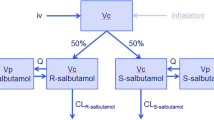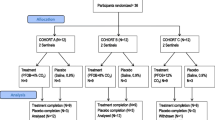Summary
In 6 asthmatic patients, the possibility of obtaining a steady state plasma level of 5 mg/l of enprofylline by administration of two constant rate infusions was examined. The simulated plasma concentration curves, based on information from pressessment of individual pharmacokinetic parameters, were in good agreement with the plasma levels obtained. The side-effects and bronchodilatation produced by enprofylline were compared to those obtained with theophylline at a steady state level of 15 mg/l. Enprofylline and theophylline caused a mean maximal increase in FEV1.0 of 14% and 2.6% per mg/l in plasma, respectively. Side-effects, head-ache, nausea and vomiting, became pronounced in 2 patients in whom the plasma enprofylline level was about 6 mg/l. No other serious adverse reaction was seen. It is suggested that enprofylline should be further evaluated as a possible anti-asthmatic drug.
Similar content being viewed by others

References
Benet L (1979) Non-compartmental determination of the steady-state volume of distribution. J Pharm Sci 68: 1071–1074
Borgå O, Lunell E, Andersson K-E, Edholm L-E, Fagerström P-O, Persson CGA (1983) Pharmacokinetics of enprofylline in healthy subjects after i.v. administration. Clin Pharmacol Ther (Submitted for publication)
Laursen L, Johannesson N, Dirksen A, Djurup R, Munch E, Taudorf E, Weeke B (1983) Enprofylline — effects of a new bronchodilating xanthine derivative in asthmatic patients. Allergy 38: 75–79
Lunell E, Svedmyr N, Andersson K-E, Persson CGA (1982) Effects of enprofylline, a xanthine lacking adenosine antagonism, in patients with reversible obstructive lung disease. Eur J Clin Pharmacol 22: 395–402
Persson CGA, Kjellin G (1981) Enprofylline, a principally new anti-asthmatic xanthine. Acta Pharmacol Toxicol 49: 313–316
Persson CGA, Erjefält I, Karlsson I-A (1981) Adenosine antagonism, a less desirable characteristic of xanthine asthma drugs? Acta Pharmacol Toxicol 49: 317–320
Pfeifer H, Greenblatt D (1978) Clinical toxicity of theophylline in relation to cigarette smoking. Chest 74: 4: 455–459
Rescigno A, Segre E (1966) Drug and tracer kinetics. Blaisdell, Waltham, Mass, Chapter 4
Wagner J (1974) A safe method for rapidly achieving plasma concentration plateaus. Clin Pharmacol Ther 16: 691–700
Author information
Authors and Affiliations
Rights and permissions
About this article
Cite this article
Laursen, L.C., Johannesson, N., Fagerström, P.O. et al. Intravenous administration of enprofylline to asthmatic patients. Eur J Clin Pharmacol 24, 323–327 (1983). https://doi.org/10.1007/BF00610048
Received:
Accepted:
Issue Date:
DOI: https://doi.org/10.1007/BF00610048



